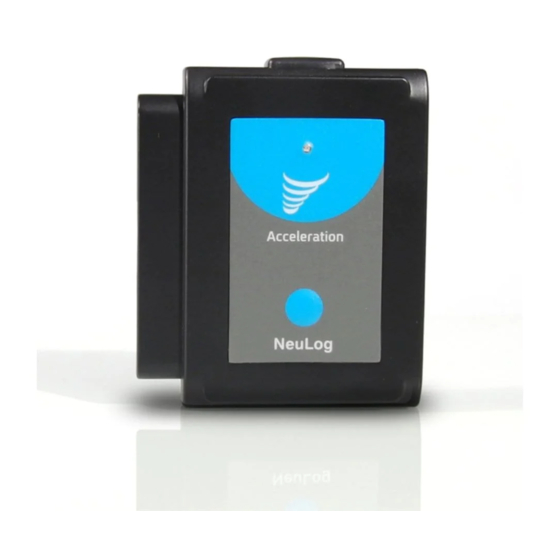
Advertisement
Quick Links
NeuLog acceleration logger sensor
NUL-227
The NeuLog acceleration sensor can be used for any science experiment or
activity which utilizes acceleration measurements such as in the fields of
Physics, Mechanics, Physiology, Exercise Science, etc.
The sensor comes pre-calibrated so you can start experimentation right out
of the box using this guide.
Hundreds of possible experimental subjects that can be done with the NUL-
227 sensors are: gravitational force, impulse, exercise studies, human and
animal acceleration, and many more
The acceleration sensor uses the following units of measure:
Meters per second squared (m/s
change in velocity over time.
Sensor orientation:
The NeuLog acceleration sensor has the ability to measure acceleration in
three different axes (X, Y, and Z). The figure below demonstrates the axes.
Note: You can also easily determine which axis is which by using this easy
method: First click on the sensor icon in the NeuLog software and select
the axis you wish to determine. Then change the physical orientation of the
acceleration sensor until the readout is roughly ± 9.8m/s
2
reads roughly ±9.8m/s
, draw an imaginary line through the sensor towards
NEULOG ACCELERATION LOGGER SENSOR GUIDE
2
): The SI unit of acceleration or
2
. When the sensor
the ground, either end of the imaginary line (sky and ground) will be the
poles of the axis in relation to the sensor you are trying to determine.
:
To view all axes simultaneously
After collecting data:
1.
Open the NeuLog software and connect the acceleration sensor using
any of the following guides.
Once the sensor has been detected, click on "Offline Experiment"
2.
3.
Click on the acceleration sensor icon on the left.
Click on the "Range" button and select an axis (X, Y, or Z).
4.
Click "Load Experiment" located on the top of the screen.
5.
6.
Select which experiment you would like to upload so that the button
turns green, the default is "Newest" ("Newest" will select the most
recent data collection)
Click on "Load Experiments" which will load the data from your
7.
chosen axis onto the graph.
8.
Resume from step 3 to load the other axes on the same graph.
Advertisement

Summary of Contents for NeuLog NUL-227
- Page 1 Note: You can also easily determine which axis is which by using this easy recent data collection) method: First click on the sensor icon in the NeuLog software and select Click on “Load Experiments” which will load the data from your the axis you wish to determine.
- Page 2 WIFI-201 module will create a closed NeuLog WiFi network which will Procedure: stream the NeuLog data to a device of your choosing. Once your device is wirelessly connected to the NeuLog network you can run experiments and Install the NeuLog software collect data through a browser of your choosing.
- Page 3 VIEW-101 Viewing Module Take your tablet or smart phone, go to the WiFi settings and select the BAT-200 Battery Neulog network which matches the WIFI-201 Module ID found on the back of the WIFI-201 device. (NeuLogXXXX for example). Procedure: Give your device about 20 seconds to connect to the WIFI-201.
-
Page 4: Sensor Features
Click the “Load data from sensors” button. Select which experimental data to upload. (5 experimental runs can be Sensor features: stored at one time on the NUL-227 acceleration sensor) Fully digital data. Restoring sensor’s factory default settings: Rugged plastic ergonomic case. - Page 5 Store in a box at room temperature out of direct sunlight. The philosophy behind NeuLog’s plug and play technology is based on each sensor’s ability to store its own data due to an internal flash memory Warranty: chip and micro-controller in each plastic NeuLog body.













Need help?
Do you have a question about the NUL-227 and is the answer not in the manual?
Questions and answers